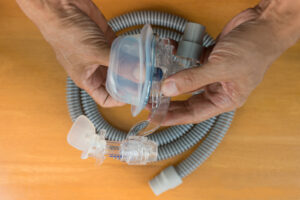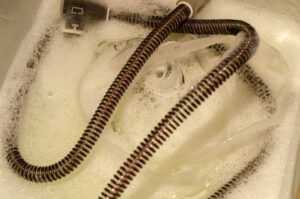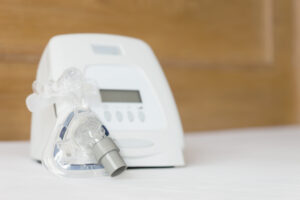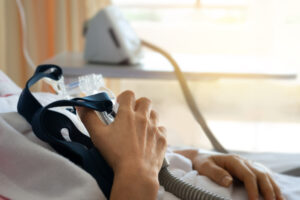A CPAP machine is a common method used to treat obstructive sleep apnea and snoring. These machines treat sleep apnea by providing a constant flow of oxygen that prevents breaks in breathing and curbs excessive snoring.
Like any machine, CPAP machines should be cleaned regularly. A dirty CPAP is a health hazard and can make you seriously ill. However, so long as you are diligent and routinely clean your CPAP machine, the risk of infection is minimal.
Guide to Cleaning a CPAP Machine

- 1 Thoroughly wash and dry your CPAP machine’s masks and tubes about once a week.
- 2 Use mild soap and warm water to clean and disinfect CPAP equipment.
- 3 Air dry all components completely before reassembling the machine.
- 4 If you have a humidifier, empty, rinse, and refill with distilled water every day.
Make cleaning your machine a regular habit to prevent CPAP side effects.
How to Clean Your CPAP Machine
CPAP cleaning and maintenance are essential in order to keep your equipment sanitary and functioning properly. Each type of machine comes with its own specific cleaning instructions and requirements from the manufacturer. There are many types of CPAP machines, which all have slight variations in their parts and structure, but there are some cleaning tips that can be applied universally.
In general, a CPAP machine consists of a compressor (motor), hose, and face or nasal mask. Each part of the CPAP needs a different type of care. Generally, the motor doesn’t require cleaning, but should get yearly maintenance to ensure its functioning. However, the mask, tube, and other headgear need regular cleaning. Typically, the mask should be wiped clean every day, and washed thoroughly once a week.
If your machine has a humidifier, it will need a fresh daily supply of sterile water. This will prevent it from growing bacteria or fungi. Many CPAP machines can be sterilized by using a mild soap and water, or specific CPAP solutions. It is recommended to detach the face or nasal mask and tubing from the main body of the machine, and soak them in warm, soapy water. They should always be hung up to dry. Drying your equipment properly is important, as it keeps the parts from growing mold or bacteria.
Masks and tubes should be replaced about twice a year. It is also important to clean and change the filter in the machine so that dust and dirt don’t accumulate. This avoids circulating dirty air. Filters are very affordable and should be changed at least once a month if not once every two weeks.
CPAP Cleaning Machines
There are many types of CPAP cleaning equipment and supplies to help you manage your CPAP machine. There are disinfection machines for those who struggle with their CPAP maintenance. Because many of the issues with CPAP machines stem from mold or mildew, most CPAP cleaner machines use activated oxygen or ultraviolet light to eradicate microbes. Both of these methods break down microorganisms and bacteria to sanitize your equipment. However, these machines are not currently FDA approved. The FDA recommends cleaning your CPAP machine with mild soap and water or vinegar.
CPAP Cleaning FAQs
A dirty CPAP machine can grow microbes and mold. Breathing these in can lead to serious health complications and illnesses, such as strep throat and pneumonia. Additionally, these can exacerbate any underlying respiratory conditions.
You can use a mild detergent, like dish soap, or a mixture of water and vinegar to clean your tubes and mask. These will keep your CPAP sanitary. There are also a variety of CPAP solutions available from CPAP cleaning suppliers to help disinfect your machine.
This depends on your machine equipment. Generally, you should change and rinse the water chamber for your humidifier (if your machine has one) every day. Masks and tubes should be washed and dried thoroughly about once a week. CPAP cleaning is an essential part of maintaining your CPAP machine.
One of the first signs of a dirty CPAP is an unpleasant odor. If it begins to smell like mold or mildew, this indicates an unclean machine. If you find yourself getting a lot of sinus or respiratory infections, this could be a sign that your CPAP machine is not being cleaned properly.
Many CPAP machines come with a built-in humidifier or people get a CPAP humidifier to mitigate dryness in the nose, mouth, and throat. The water for the humidifier should be distilled or sterile–not tap water–to ensure there aren’t chemicals or molecules that could make you sick. If your machine uses a humidifier you should empty the chamber, rinse, and refill the water daily.
References
Ask the Sleep Doctor
Have questions about sleep? Submit them here! We use your questions to help us decide topics for future articles, videos, and newsletters. We try to answer as many questions as possible. You can also send us an email. Please note, we cannot provide specific medical advice, and always recommend you contact your doctor for any medical matters.









